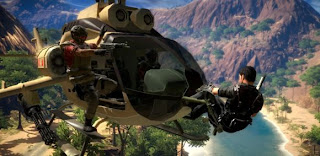As a gamer I have played many different types of game. In this blog entry I am going to describe two games I have recently played. One game fits under the ‘Paidea’ category the other, ‘Ludus’.
Paidea: effectively play for pleasure.
Ludus: more constrained by rules, with a clear outcome.
Paidea Game: Just Cause 2
Just Cause 2, the sequel to Just Cause, is a sandbox game set in a truly massive open world, made up of a collection of large and small islands. The player controls the protagonist an FBI agent named Rico Rodriguez, and travels around the environment, completing missions for 3 rival gangs. The ultimate aim of the game is to destabilise and eliminate the evil dictator, one "Baby Panay", by causing chaos throughout the game-world.
Rico can cause chaos in a large number of ways; by attacking military bases, destroying pipelines, wind turbines, oil rigs etc or by completing a variety of missions for 3 rival factions. Each faction has an 'area of influence' which encompasses a segment of the game's map. Each time the player completes a set number of missions for a faction, the 'area of influence' will grow and the player will receive a substantial boost to their chaos count.
As you can see the game does contain ludic elements, but the appeal of the game is the tremendous freedom it lends the player. Rico is armed with a deadly combination of an all purpose grappling hook device; which can attach itself to any surface, be it metal, human flesh, or a mountain, and a quick deploying parachute, perfect for sky diving off of mountains and buildings in the game world.
When these tools are used together the player can perform a technique called the 'slingshot', firstly the player must grapple towards a solid surface, secondly the player must engage the parachute in mid-air whilst Rico is being pulled towards the surface. If executed correctly the player will 'slingshot' into the air, maintaining the momentum gained from the grappling hook, the player will now be free to glide around using the parachute, and can speed up their flight by grappling onto the terrain as they fly past. This method of transport is both thrilling and fast and is one of the best ways to move around the gigantic world the game contains. Alternatively the player can drive several different types of vehicles ranging from cars, to motorbikes, to helicopters and finally planes, both military fighter jets, and commercial airliners.
Ultimately I believe that Just Cause 2 is a Paidea game because it gives players all the tools they'll need to explore and destroy the game world, yes they can complete the missions, but the real appeal of the game lies within the sandbox setting and the tools the player is given to interact with it.
Ludus Game: Portal
Portal is a puzzle/platform game created by valve to be packaged with the Orange Box. (The Orange Box contains; Half Life 2, Team Fortress 2, Portal, Half Life 2 Episode 1 and lastly Half Life 2 Episode 2). The player controls the protagonist Chell and guides her through a series of progressively difficult rooms in the aperture science underground laboratory. The player accomplishes this by using the 'Portal Gun' the games namesake, to create portals, one blue and one orange. The player can only create two portals at any one time.
The portals act like doorways and exits, so if the player enters the blue portal they will exit from the orange portal and vice versa. Here is a simple example from within the game; the player needs to get past a high wall that is in their path. The wall doesn't extend to the ceiling allowing the player to see over the wall. One way to get past this obstacle is for the player to first create a blue portal on the ceiling of the far room, next the player creates an orange portal on the wall next to them. If they look through this orange portal they will see the room on the other side of the wall, from a birds eye view. The final step simply requires the player to walk through the orange portal, whereupon they will exit the blue portal in mid-air and land in the room. This sounds complicated but in practise it is easy to grasp.
As the player moves throughout each room, they will receive information from GLADOS the AI entity that runs the aperture science facility.
The ultimate aim of the game is to complete each room and end the testing process. In this way I believe the game is ultimately ludic in nature.
I found it interesting to look at games using the 'paidea' and 'ludus' terms.
Thanks for reading. :)
Bibliography
Just Cause 2 (Xbox 360) Avalanche Studios, Eidos Studios
Portal (PC) Valve
Bibliography
Just Cause 2 (Xbox 360) Avalanche Studios, Eidos Studios
Portal (PC) Valve


For Caillois, the terms are opposite ends on a continuum (although he didn't have computer games in mind when he wrote _Man, Play and Games_ in 1958).
ReplyDelete